#ernest cossart
Text
Here are 10 things you should know about Ernest Cossart, born 147 years ago today. His Hollywood career was brief, but butler-iffic.
#Ernest Cossart#Character Actors#old movies#classic film#classic movies#classic hollywood#classic Broadway#Golden Age of Hollywood
3 notes
·
View notes
Photo
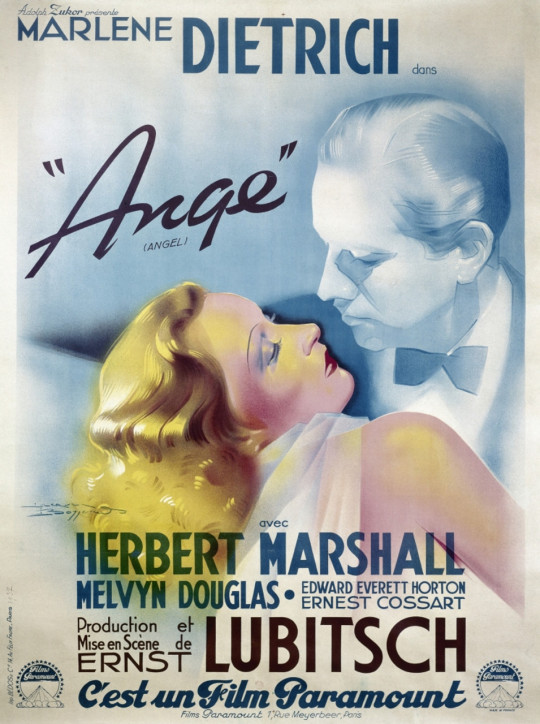
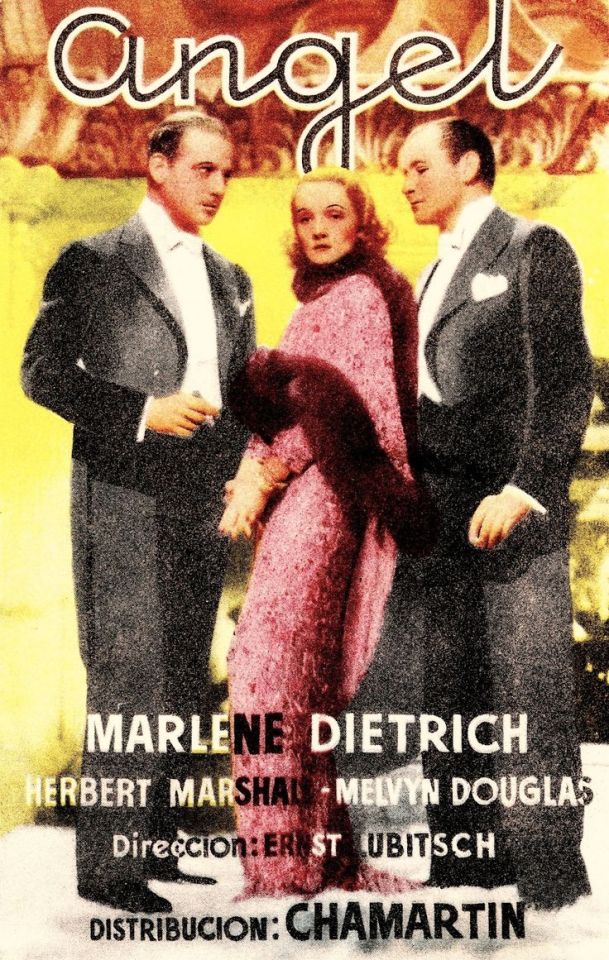


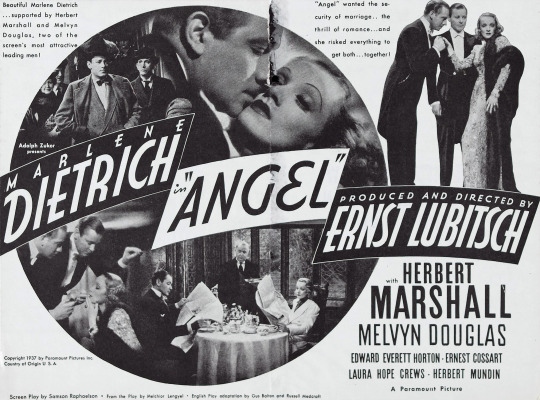
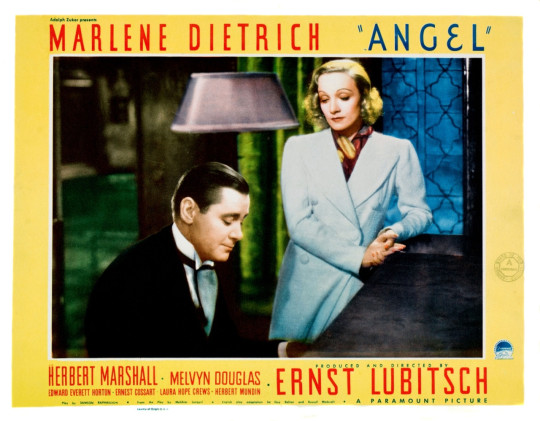

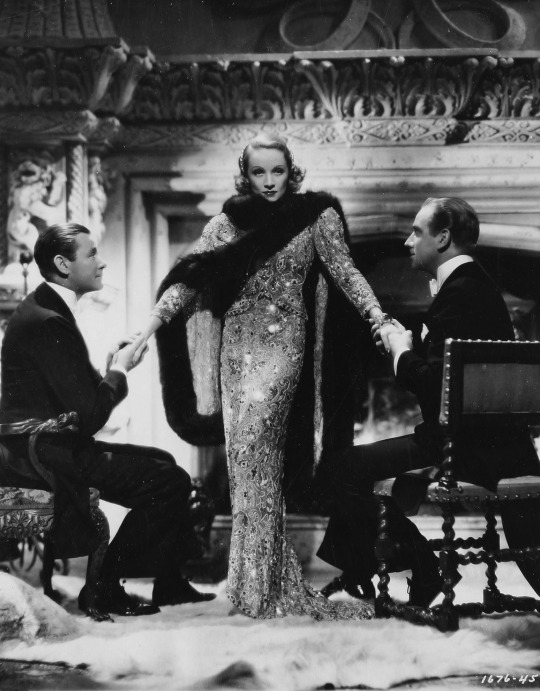
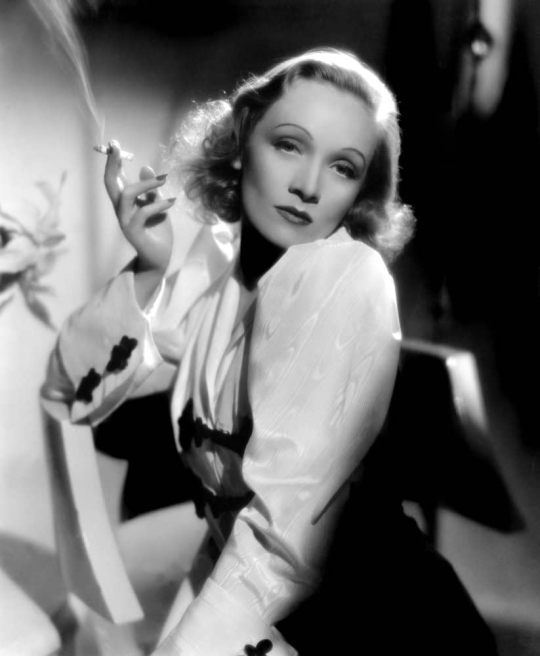

Angel (1937) Ernst Lubitsch
November 29th 2022
#angel#1937#ernst lubitsch#marlene dietrich#melvyn douglas#herbert marshall#edward everett horton#ernest cossart#laura hope crews#herbert mundin
3 notes
·
View notes
Photo
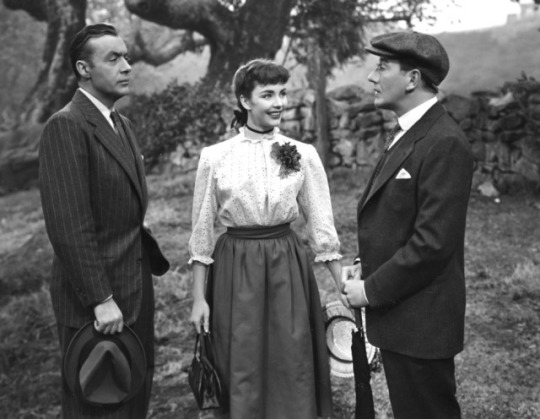
Charles Boyer, Jennifer Jones, and Richard Haydn in Cluny Brown (Ernst Lubitsch, 1946)
Cast: Charles Boyer, Jennifer Jones, Peter Lawford, Helen Walker, Reginald Gardiner, Reginald Owen, C. Aubrey Smith, Richard Haydn, Margaret Bannerman, Sara Allgood, Ernest Cossart, Una O'Connor, Florence Bates, Billy Bevan. Screenplay: Samuel Hoffenstein, Elizabeth Reinhardt, based on a novel by Margery Sharp. Cinematography: Joseph LaShelle. Art direction: J. Russell Spencer, Lyle R. Wheeler. Film editing: Dorothy Spencer. Music: Cyril J. Mockridge.
Ernst Lubitsch's celebrated "touch" was mostly a good-humored, occasionally naughty irony and a flair for pulling off sly sight gags such as the one that ends Cluny Brown: Cluny (Jennifer Jones) and Belinski (Charles Boyer) are looking at his book in a shop window when she's suddenly taken faint, followed by a cut to the shop widow in which a sequel to Belinski's book is now displayed. The gag works only if you've caught the set-up, a joke I needn't spoil, but it's a reminder that Lubitsch, like so many of the great directors of the '30s and '40s, learned his trade in silent films. Which makes it all the more amazing that he was so deft with dialogue. Cluny Brown is also a great showcase for its stars, Boyer and Jones, who were never quite so charming in any of their other films. Especially Jones, who was manipulated by David O. Selznick into so many roles that she had no business playing, such as the supposedly sultry Pearl Chavez in Duel in the Sun, a film that appeared the same year as Cluny Brown, but whose action seems to be taking place in another galaxy. That Jones could move from Pearl to Cluny with such grace suggests that she was a finer actress than Selznick ever let her be. Cluny also showcases some wonderful character actors, especially the always welcome Richard Haydn as Cluny's unsuitably prissy would-be fiancé and Una O'Connor as his mother, whose "dialogue" consists of clearing her throat. But mostly the Lubitsch finesse is what saves Cluny Brown from turning into the twee horror it might have been with its gallery of talkative eccentrics and off-beat situations. Instead, it's a refreshingly delicate comedy shadowed only by the fact that it was to be its director's last completed film, a reminder of the exchange that took place at Lubitsch's funeral when Billy Wilder sighed, "No more Lubitsch," and William Wyler replied, "Worst than that. No more Lubitsch pictures."
2 notes
·
View notes
Link
Check out this listing I just added to my Poshmark closet: SHEET MUSIC 1946 The Jolson Story Anniversary Song.
0 notes
Photo

#cluny brown#charles boyer#jennifer jones#peter lawford#helen walker#reginald gardiner#reginald owen#c. aubrey smith#richard haydn#margaret bannerman#sara allgood#ernest cossart#florence bates#una o'connor#ernst lubitsch#1946
4 notes
·
View notes
Photo

Ernest Cossart-Ginger Rogers “Espejismo de amor” (Kitty Foyle: the natural history of a woman) 1940, de Sam Wood.
7 notes
·
View notes
Photo

I really liked Kitty Foyle! Both the film and the character. Quite a snazzy lady, I liked her cheeky comment about Wyn’s voice and the funny little dates with Mark, at some point I was kind of rooting for both but I’m happy with how it turned out. What a great role, a well deserved Oscar; Best Actress in a Leading Role for Ginger Rogers.
#kitty foyle#ginger rogers#dennis morgan#james craig#eduardo ciannelli#ernest cossart#gladys cooper#odette myrtil#1940#theoscarchallenge
2 notes
·
View notes
Text
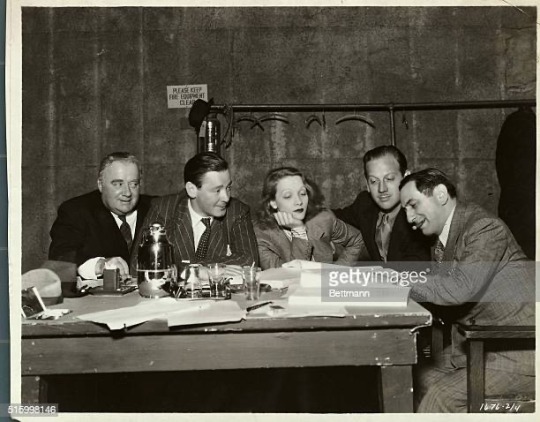
Ernest Cossart, Herbert Marshall, Marlene Dietrich, Melvyn Douglas, and director Ernst Lubitsch read through the script during rehearsal for ANGEL (1937)
22 notes
·
View notes
Text



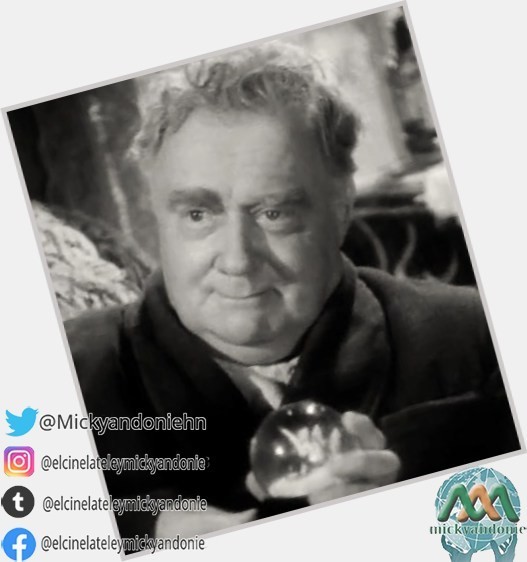
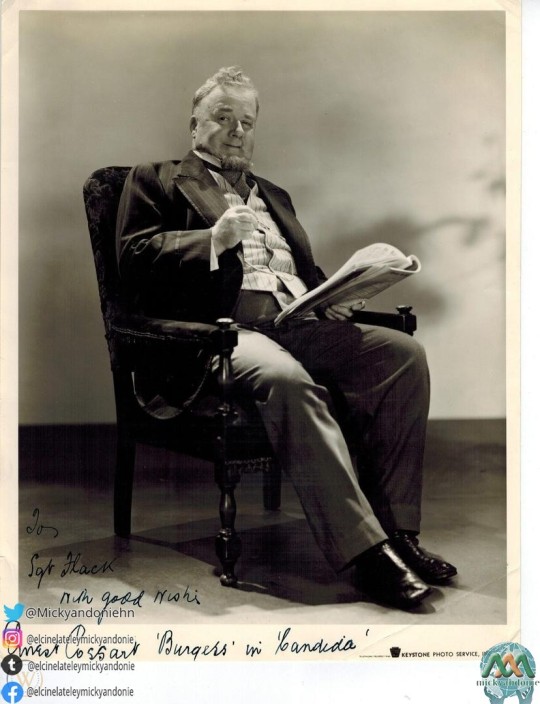
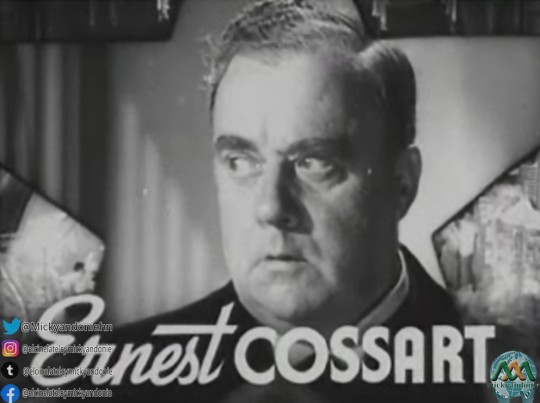
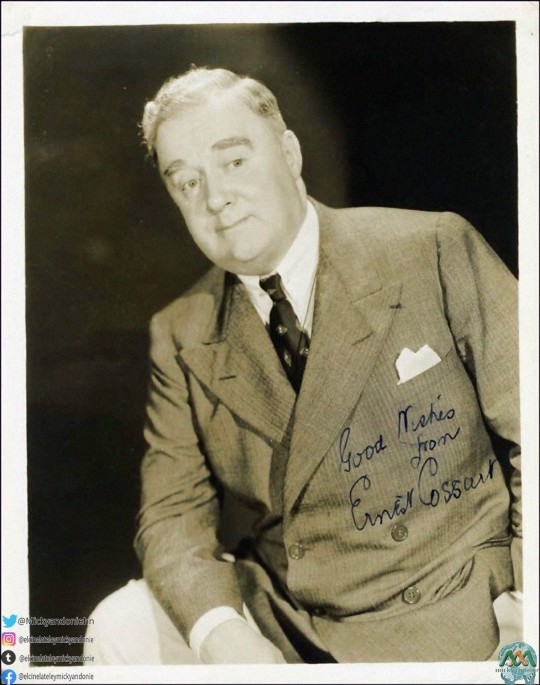


Ernest Cossart.
Filmografía
Cine
1916: The Pursuing Vengeance, de Martin Sabine.
1935: The Scoundrel, de Ben Hecht y Charles MacArthur.
1936: El gran Ziegfeld, de Robert Z. Leonard.
1936: Three Smarts Girls, de Henry Koster.
1936: Murder with Pictures, de Charles Barton.
1937: Angel, de Ernst Lubitsch.
1937: Champagne valse, de A. Edward Sutherland.
1939: Zaza, de George Cukor.
1939: Tower of London, de Rowland V. Lee.
1939: Three Smart Girls Grow Up, de Henry Koster.
1939: The Light that Failed, de William A. Wellman
1939: Lady of the Tropics, de Jack Conway.
1940: Kitty Foyle, de Sam Wood.
1940: Tom Brown's School Days, de Robert Stevenson.
1941: Skylark, de Mark Sandrich.
1942: Kings Row, de Sam Wood.
1945: Love Letters, de William Dieterle.
1945: Tonight and every Night, de Victor Saville.
1946: Cluny Brown, de Ernst Lubitsch.
1946: The Jolson Story, de Alfred E. Green
1947: Love from a Stranger, de Richard Whorf.
1949: John Loves Mary, de David Butler.
Teatro (Broadway)
1908: The Girls of Gottenberg, música de Ivan Caryll y Lionel Monckton, letras de Adrian Ross y Basil Hood.
1910: Mrs. Dot, de William Somerset Maugham, con Billie Burke.
1910: Love among the Lions, de Winchell Smith a partir de F. Anstey, con Ivan F. Simpson
1911: The Zebra, de Paul M. Potter a partir de Marcel Nancey y Paul Armont.
1912: The Typhoon, de Emil Nyitray y Byron Ongley a partir de Menyhert Lengyel.
1914: Marrying Money, de Washington Pezey y Bertram Marbugh.
1915: Androcles and the Lion, de George Bernard Shaw.
1915: The Man who married a Dumb Wife, de Anatole France, con Isabel Jeans.
1915: El sueño de una noche de verano, de William Shakespeare, con Isabel Jeans.
1915: The Doctor's Dilemma, de George Bernard Shaw.
1915: Sherman was right, de Frank Mandel.
1920-1921: The Skin Game, de John Galsworthy.
1921: The Title, de Arnold Bennett, interpretada y dirigida por Lumsden Hare.
1922: HE Who gets slapped, de Leónidas Andreiev, adaptada por Gregory Zilboorg, con Richard Bennett, Margalo Gillmore, Edgar Stehli, Henry Travers y Helen Westley.
1922: From Morn to Midnight, de Georg Kaiser, adaptada por Ashley Dukes, con Allyn Joslyn, Edgar Stehli, Henry Travers y Helen Westley.
1922-1923: Seis personajes en busca de autor, de Luigi Pirandello, adaptada por Edward Storer, con Florence Eldridge.
1923: The Love Habit, adaptación de Gladys Unger a partir de Pour avoir Adrienne, de Louis Verneuil, con Florence Eldridge.
1923: Casanova, de Lorenzo De Azertis, adaptada por Sidney Howard.
1923-1924: Santa Juana, de George Bernard Shaw, con Henry Travers.
1924: Seis personajes en busca de autor.
1924: The Steam Roller, de Laurence Eyre.
1924-1925: Cándida, de George Bernard Shaw, con Pedro de Cordoba.
1925-1926: Arms and the Man, de George Bernard Shaw, con Pedro de Cordoba y Henry Travers.
1926: The Chief Thing, de Nikolaï Evreinov, adaptada por Leo Randole y Herman Bernstein, con Romney Brent, Edward G. Robinson, Lee Strasberg, Henry Travers y Helen Westley.
1926-1927: Loose Ankles, de Sam Janney.
1926-1927: What never dies, de Alexander Engel, adaptada por Ernest Boyd.
1927-1928: The Doctor's Dilemma, de George Bernard Shaw, con Margalo Gillmore, Alfred Lunt, Henry Travers y Helen Westley.
1928: Marco Millions, de Eugene O'Neill, escenografía de Rouben Mamoulian, con Robert Barrat, Albert Dekker, Margalo Gillmore, Alfred Lunt, Vincent Sherman y Henry Travers.
1928: Volpone, de Ben Jonson, adaptada por Ruth Langner, con Albert Dekker, Margalo Gillmore, Alfred Lunt, Vincent Sherman, Henry Travers y Helen Westley.
1928-1929: Caprice, de Philip Moeller, con Douglass Montgomery.
1929: Becky Sharp, de Langdon Mitchell, a partir de La feria de las vanidades, de William Makepeace Thackeray, con Etienne Girardot, Arthur Hohl, Basil Sydney y Leonard Willey.
1930: The Apple Cart, de George Bernard Shaw, con Violet Kemble-Cooper, Tom Powers, Claude Rains y Helen Westley.
1930: Milestones, de Arnold Bennett y Edward Knoblauch, con Beulah Bondi y Selena Royle.
1931: Getting Married, de George Bernard Shaw, con Romney Brent, Dorothy Gish, Henry Travers y Helen Westley.
1931: The Way of the World, de William Congreve, con Walter Hampden, Gene Lockhart, Kathleen Lockhart, Selena Royle y Cora Witherspoon.
1931: The Roof, de John Galsworthy, con Henry Hull y Selena Royle.
1932: The Devil passes, de Benn W. Levy, con Eric Blore, Arthur Byron, Mary Nash y Basil Rathbone.
1932: Too true to be good, de George Bernard Shaw, escenografía de Leslie Banks, con Leo G. Carroll y Claude Rains.
1933: The Mask and the Face, de W. Somerset Maugham, con Leo G. Carroll y Humphrey Bogart
1933-1934: Mary of Scotland, de Maxwell Anderson, con Helen Hayes, Edgar Barrier, George Coulouris, Philip Merivale, Moroni Olsen y Leonard Willey.
1935: Accent on Youth, de Benn W. Levy
1937: Madame Bovary, de Benn W. Levy, a partir de Gustave Flaubert, con Eric Portman y O. Z. Whitehead.
1945: Devils Galore, de Eugene Vale.
1948: The Play's the Thing, de Ferenc Molnár, adaptada por P. G. Wodehouse, con Louis Calhern, Francis Compton y Faye Emerson.
1949: The Ivy Green, de Mervyn Nelson, con Hurd Hatfield.
Créditos: Tomado de Wikipedia
https://es.wikipedia.org/wiki/Ernest_Cossart
19 notes
·
View notes
Text
about Angel (1937)

—The only Marlene Dietrich movie directed by Ernst Lubitsch (though the year before he was the producer of Desire). One might expect them to bring out the scintillating best in each other, but the picture is too prettily contrived, and the craftsmanship is right on the surface. Dietrich plays the lonely foreign wife of an eminent English diplomat (Herbert Marshall); she skips off for a day to Paris and visits a house of assignation (euphemistically called a salon) presided over by Laura Hope Crews. There she meets Melvyn Douglas (another government official), and he falls passionately in love with her. Naturally, he turns up at her London home. This is one of Dietrich’s stiffest, most impassive performances; the role doesn’t give her anything to do but look blankly frightened that her husband will discover her guilty secret. Boredom must have set in for her, because when she has to express emotional turmoil she rattles off her lines without conviction. For want of action, the movie keeps cutting to what’s going on among the fleet of servants, which in- cludes Ernest Cossart and also Edward Everett Horton, who playacts as if to an audience of fey 3-year-olds. This movie isn’t essentially different from the best of Lubitsch, but it’s attenuated. It’s the sort of cultivated triangular love affair in which each of the three has a turn at the piano, and Marshall and Douglas, whose acting is a matter of lifted eyebrows and the smallest shifts of inflection, have the affable man-of-the-world conversations that were a feature of “pol- ished” 30s comedies. With Herbert Mundin, Ivan Lebedeff, Dennie Moore, and Herbert Evans. The screenplay is by Samson Raphaelson, from a play by Mel- chior Lengyel. Paramount. b & w
1 note
·
View note
Text
One Foot In Heaven (1941)
Today's review on MyOldAddiction.com, One Foot In Heaven by #IrvingRapper starring #FredricMarch and #MarthaScott, "only gets involved with a vague concept of Christian religion"
IRVING RAPPER
Bil’s rating (out of 5): BBB.
USA, 1941. Warner Bros.. Screenplay by Casey Robinson, based on the book by Hartzell Spence. Cinematography by Charles Rosher. Produced by Irving Rapper. Music by Max Steiner. Production Design by Carl Jules Weyl. Costume Design by Milo Anderson. Film Editing by Warren Low. Academy Awards 1941.
[youtube=https://www.youtube.com/watch?v=fILAUG_…
View On WordPress
#Academy Award 1941#Beulah Bondi#Carl Jules Weyl#Carlotta Jelm#Casey Johnson#Casey Robinson#Charles Rosher#Elisabeth Fraser#Ernest Cossart#Frankie Thomas#Fredric March#Gene Lockhart#Grant Mitchell#Harry Davenport#Hartzell Spence#Irving Rapper#Jerome Cowan#Laura Hope Crews#Martha Scott#Max Steiner#Milo Anderson#Moroni Olsen#Nana Bryant#Peter Caldwell#Warner Bros.#Warren Low
0 notes
Text
Here are 10 things you should know about Ernest Cossart, born 145 years ago today. His Hollywood career was brief, but butler-iffic.
#Ernest Cossart#old movies#classic film#classic movies#classic Hollywood#character actors#Golden Age of Hollywood#classic Broadway#British actors
0 notes
Photo



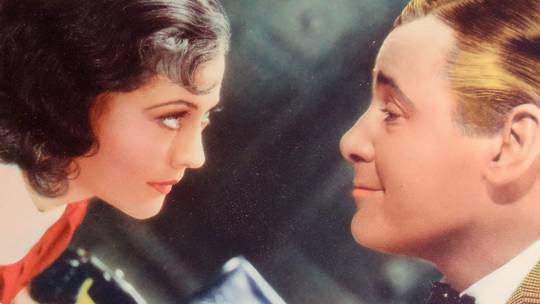
Accent on Youth (1935) Wesley Ruggles
April 5th 2021
#accent on youth#1935#wesley ruggles#sylvia sidney#herbert marshall#ernest cossart#phillip reed#holmes herbert#astrid allwyn
9 notes
·
View notes
Photo
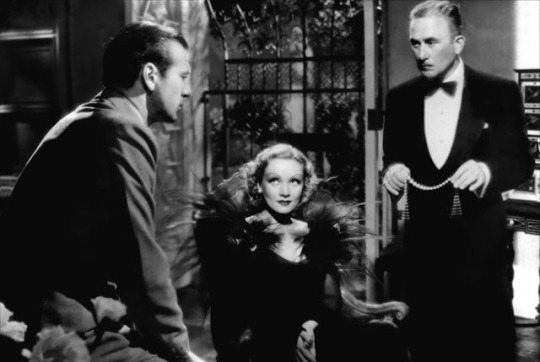
Gary Cooper, Marlene Dietrich, John Halliday in Desire (Frank Borzage, 1936)
Cast: Marlene Dietrich, Gary Cooper, John Halliday, William Frawley, Ernest Cossart, Akim Tamiroff, Alan Mowbray, Zeffie Tilbury. Screenplay: Edwin Justus Mayer, Waldemar Young, Samuel Hoffenstein, based on a play by Hans Székely and Robert A. Stemmle. Cinematography: Charles Lang. Art direction: Hans Dreier, Robert Usher. Film editing: William Shea. Costume design: Travis Banton. Music: Friedrich Hollaender.
Frank Borzage's Desire was one of the first films Marlene Dietrich made after she and Josef von Sternberg went their separate ways. Though she's still very much in the Sternberg mode in her makeup, her consciousness of the way she's being lighted, and the couture by Travis Banton, she's also softer, funnier, and more human. She also benefits from being re-teamed with Gary Cooper, her co-star in Sternberg's Morocco (1930), and the only leading man with whom she had any real chemistry in the Sternberg films. Desire is still glamorous nonsense, a romantic comedy in which Dietrich plays a jewel thief and Cooper a seemingly naïve American automotive engineer. They meet on the road to Spain, where Cooper's Tom Bradley plans to spend his vacation and Dietrich's Madeleine de Beaupre is meeting up with her accomplice, Carlos Margoli -- a part planned for John Gilbert that went to John Halliday after Gilbert suffered a heart attack. Cooper is delightful as the infatuated American, whose native shrewdness manifests itself eventually. A subtext about the unsettled situation in Europe runs through the film, though there's no direct reference to the civil war brewing in Spain. Tom Bradley is not one to be outwitted by Europeans like Carlos, who, in a conversation about whether the United States would get involved if war breaks out in Europe, observes, "America's a very large country." Tom replies, "Six feet three." Like most good romantic comedies, Desire gets the best out of its supporting players, including Ernest Cossart as the jeweler and Alan Mowbray as the neurologist whom Madeleine plays off against each other to get her hands on the loot, Akim Tamiroff as a police officer, and Zeffie Tilbury as the larcenous, tippling Aunt Olga. Ernst Lubitsch, who produced, also directed some scenes while Borzage was finishing up another film, and his celebrated touch gives Desire some of its vivacity.
3 notes
·
View notes
Photo
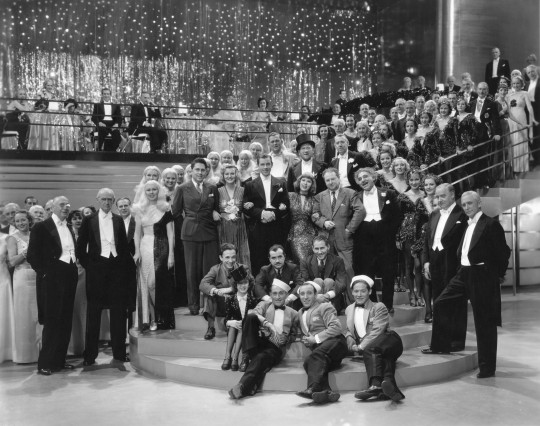
A part of the galaxy of stars who appear in the musical extravaganza, "Top of the Town" which features Doris Nolan and George Murphy, pose for a picture; first row: Peggy Ryan, and the Three Sailors; Second row: Gene Snyder, dance director, Joe Valentine, cameraman, Sam White, production associate. Third row: Richard Carle, Claude Gillingwater, producer Lou Brock, Doris Nolan, George Murphy, Gertrude Niesen, Ernest Cossart, Samuel Hinds. Fourth row: Ray Mayer and Gregory Ratoff.
0 notes
